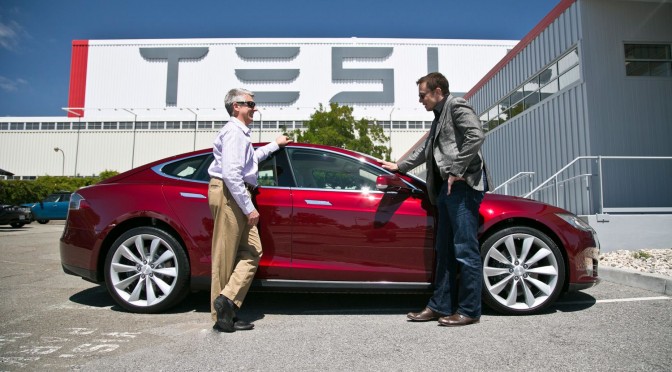Tesla Motors CEO Elon Musk is one of the few innovators building a new business to support his existing business.
To support customers of Tesla electric vehicles including its flagship Model S electric car, Musk is expanding a network of “Supercharger” stations across the U.S. where users can charge their electric cars.
To incentivize the electric car economy to grow, these Supercharger stations allow Tesla drivers to recharge their cars for free, for life.
To accomplish his vision of a U.S. where people drive electric cars from coast to coast, Musk wants to work with other innovators to build a new economy for electric batteries and stations to charge them, much the same way highways and gas stations sprang up to make the great American road trip possible.
“I traveled with my family from Los Angeles to South Dakota, to Mount Rushmore using the Supercharger network,” Musk told U.S. News, boasting that Tesla drivers travel from New York to Los Angeles using the network.
To make the electric car economy more convenient, Musk has said Tesla would share its Supercharger network with automakers interested in helping to create an industry standard, if an automaker could design electric cars that meet the fast-charging standard of the Supercharger and offer free recharging to customers on that network.
“As Elon has repeatedly made clear…we are very open to have electric vehicles made by other manufacturers use Superchargers,” said an email from Alexis Georgeson, spokeswoman for Tesla. “They’d just have to contribute to the capital cost, such as determining what percentage of the time their cars are using the Supercharger network and making a contribution proportionate to that. The issue of non-Tesla electric vehicles currently being unable to use Superchargers comes down to the fact that no other electric car can accept anything close to 135kw, which is the power level of Tesla’s Superchargers.”
Serial entrepreneur Musk made his fortune as a co-founder of PayPal, which was acquired by e-commerce giant eBay in 2002. Musk used his profits from the sale to fund rocket ship company Space Exploration Technologies in 2002. Musk founded Tesla in 2003 and solar energy company Solar City in 2006.
During an exposition of the latest SpaceX Dragon craft Tuesday, Musk would not go into details about Supercharger patents. Instead, the futurist shared some of his hopes for the electric car battery economy, including Tesla’s plan to build a $5 billion “Gigafactory” to create lithium ion cells and perhaps make alternative energy vehicles a more affordable part of everyday life.
The battery factory may help Tesla reach its goal of producing an electric car that will sell for less than $40,000 by 2017, as opposed to its Model S sedan, which today costs more than $70,000. Finalists for the location of the Gigafactory are Nevada, Arizona, New Mexico and Texas, chosen for their sun-baked desert areas that are ideal for a solar-powered factory.
“We have not decided where it is going to be built, but we have narrowed it down,” Musk told U.S. News. “Ultimately there will be many such battery factories.”
The trouble with Tesla’s Gigafactory strategy is that it is dependent on a massive supply of lithium ion, which stores the electrical charge in its batteries, says Patrick Tucker, author of “The Naked Future” and former spokesman for the World Future Society.
“Lithium ion is a finite resource since it is made of a variety of a rare earth metals,” Tucker explains. “Many of them are in areas like South and Central America, in China and Africa. There is no stable, permanent, one-nation supply for all of the materials that go into making it.”
Reliance on lithium ion “is unsettling,” Tucker says, because the need to secure a supply from different regions of the world could make it a national security risk. To hedge against that risk, Tucker argues there should be more effort on development of better hydrogen batteries, which could be a more readily available resource than lithium ion.
Toyota has developed a hydrogen-powered fuel cell vehicle, which generates electricity from a chemical reaction using hydrogen and oxygen stored in the battery. Toyota may begin production and perhaps sales of its fuel cell vehicle in December, Japan Times reports.
When asked about these concerns, Musk told U.S. News “lithium ion is the path” Tesla will take for its battery strategy because it is the most effective electrical storage method available.
“There is nothing better than lithium ion even in a lab as far as I have seen,” Musk says. “That’s not to say there won’t be a breakthrough sometime, but I have not yet seen demonstrations even at a lab level that are better than lithium ion.”
In the spirit of advancing electric car science Musk says if anybody has a method better than lithium ion battery storage “I would like if they could send me it.”
“It doesn’t even have to be us. It could even be a third party,” Musk says, encouraging major research centers to work with innovators to verify the results of better battery methods, noting Argonne National Laboratory outside of Chicago as a resource for testing,
“Overall I am really optimistic on a whole lithium ion battery economy and a large, deep supply chain that has all the ingredients to make it to scale,” Musk says. “So far our conversations with the mining and refining companies have been very good, much better than I expected.”
Musk’s spirit for collaborating on science includes a concept he proposed in 2013 for a “Hyperloop” high speed train between Los Angeles and San Francisco. He’s a busy man with three companies to run, so he shared a 57-page “alpha design” plan online explaining how the train could work in case anybody decided to build it.


